Epidermal growth factor receptor signaling is partially responsible for the increased matrix metalloproteinase-1 expression in ocular epithelial cells after UVB radiation
- PMID: 16049334
- PMCID: PMC1603570
- DOI: 10.1016/S0002-9440(10)62992-6
Epidermal growth factor receptor signaling is partially responsible for the increased matrix metalloproteinase-1 expression in ocular epithelial cells after UVB radiation
Abstract
Pterygia are inflammatory, invasive, and proliferative lesions of the human ocular surface in which the matrix metalloproteinase (MMP) collagenase-1 (MMP-1) is highly expressed. Pterygia development may involve MMP-1 activity against interstitial fibrillar collagen, an abundant extracellular matrix component of the cornea, and its induction by ultraviolet light (UVB). We examined the pathways responsible for enhanced expression of MMP-1 in pterygium epithelial cells after UVB exposure and/or treatment with chemical inhibitors of mitogen-activated protein kinases or epidermal growth factor receptor. The induction of MMP-1 by UVB was comparable to that mediated by heparin-binding epidermal growth factor-like growth factor and epidermal growth factor. The epidermal growth factor receptor inhibitor PD153035 partially blocked the UVB-mediated induction of MMP-1 and totally abrogated its production after stimulation with either heparin-binding epidermal growth factor-like growth factor or epidermal growth factor. UVB exposure enhanced the phosphorylated form of ERK1/2 in a time-dependent manner whereas the ERK1/2 inhibitor PD98059 decreased this induction by at least fivefold. Transcripts for c-jun and c-fos were detected as early as 2 hours after UVB exposure and were suppressed by PD98059. The identification of a specific intracellular signaling pathway responsible for the enhanced production of a key enzyme that denatures intact fibrillar collagen has important implications for understanding the pathophysiology and future therapy for pterygia.
Figures
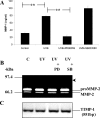
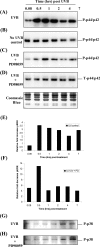
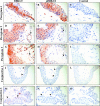
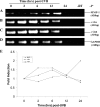
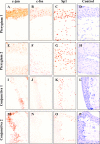


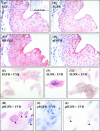
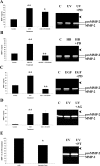
References
-
- Coroneo MT, Di Girolamo N, Wakefield D. The pathogenesis of pterygia. Curr Opin Ophthalmol. 1999;10:282–288. - PubMed
-
- Hilgers JHC. Pterygium: its incidence, heredity and etiology. Am J Ophthalmol. 1960;50:635–644. - PubMed
-
- Threlfall TJ, English DR. Sun exposure and pterygium of the eye: a dose-response curve. Am J Ophthalmol. 1999;128:280–287. - PubMed
Publication types
MeSH terms
Substances
LinkOut - more resources
Full Text Sources
Research Materials
Miscellaneous

